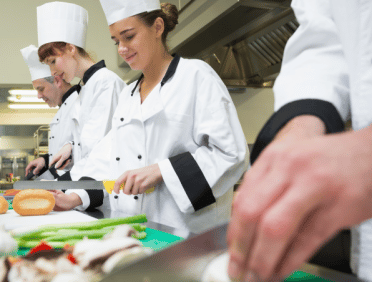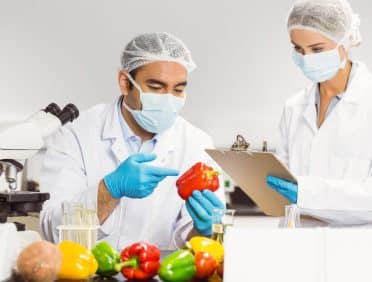Food hygiene safety is a core part of business. If you are a company that handles or sells food, you need to understand how food hygiene safety works.
There are four core components to think about with food hygiene safety. These are known as the 4C’s, and they will be important.
LearnQ can provide core training in these areas. Our teams have lots of experience in this area, and can help to offer practical qualifications that will guarantee success. For now, let’s look at the core components of food hygiene safety.
What is Food Hygiene Safety?
Food hygiene and safety are important aspects of food establishments. Between the two terms, there are a wide range of areas covered that help to guarantee food is not only fit for consumption, but safe as well.
Food hygiene safety is the term given to describe a management system that is applied by a business to help ensure that food hazards are controlled and regulated to acceptable levels. It’s impossible to create a kitchen space or a food environment that is completely free from risk, but the risk can be brought down to a low level.
Food safety is generally concerned with different types of hazards, and introduces a system of monitoring, corrective actions, and the steps needed to take safe operations. Food safety is very much an umbrella term, and food hygiene falls under the umbrella. Specifically, food hygiene is all about taking the primary lessons of food safety and applying them in the safest way.
Food safety is all about a holistic method to managing and controlling food safety hazards. This can range from things like the sourcing of raw material, food packaging, transporting, processing, and storing the products until they are ready to be sold.
During the processing stage of food production, the food is vulnerable to chemical, biological, physical and allergenic risks.
Food hygiene standards usually focus on the conditions and procedures that help prevent the contamination of food, which helps to mitigate the risk of foodborne illnesses. Food hygiene standards can cover things like cleaning, food handling, preventing cross contamination, and other factors.
Why is Food Hygiene Important?
As a business that prepares and sells food, food hygiene is very important. Obviously, you have a legal responsibility to make sure that the food you sell to your customers is not going to cause them harm. In all cases, this means suitable food hygiene and safety practices.
Besides the legal requirement to protect customers from danger, food hygiene is important for things like your reputation. As part of your normal business operations, you will have a food hygiene rating, delivered by the local authority, and a low rating will damage the reputation of your business.
Who is Food Hygiene Safety For?
A business that works with food in any capacity needs to understand the basics of food hygiene safety. This can range from small cafés to big restaurants. If a member of staff is going to be involved with the handling and preparation of food, they need food hygiene safety training.
There are a handful of exemptions for food hygiene safety training like, for example, small businesses that sell pre-packaged goods without the need for a refrigerator – a gift shop. However, the bulk of shops, restaurants, cafés, pubs, and bars that prepare and sell food as part of their menu need food hygiene safety training.
Food hygiene safety is a vital part of everyday operations, so it is also important to understand that pretty much everybody is responsible for it.
As a team member handling food on a regular basis, you would be responsible for food hygiene safety regarding the parts of the food you prepare and handle. Obviously, your colleagues would also be responsible for anything they were handling.
However, in terms of a general training sense, the responsibility for food hygiene safety falls to your employer. Legally, your employer has a responsibility to make sure that you receive suitable food hygiene safety training, and to provide the equipment and environment to achieve this.
Food Hygiene Safety 4Cs
So, there are four core components of food hygiene safety. It’s important to understand how each one relates to food hygiene safety, and the responsibilities that come under each category. Let’s take a look at them.
Each component of basic food hygiene safety is an important part of everyday operations, and the right training will equip learners with a comprehensive education in each area.
Cleaning
Being able to keep surfaces clean and tidy is a core part of food hygiene safety. Not only does this help to guarantee the health and safety of your customers, but it also prevents the spread of pathogens in the workplace.
There are germs which are capable of living outside the human body for months at a time, which means that they need to be destroyed as quickly as possible, in a very thorough manner. This mandates the need for suitable cleaning practices.
You should always disinfect and clean an area immediately after food preparation has taken place in it. This is very important for health and social care, because you are likely to be interacting with high risk groups. However, this is just as valid everywhere else.
Your employer is responsible for making sure that you have the skills required to keep your team and your customers happy and in good health. As such, they have a responsibility to provide you with access to a food hygiene course to deliver the necessary health and safety training.
Cooking
Once food has been prepared, you have to make sure that it is cooked properly before you serve it to people.
In a busy kitchen environment, it can be very tempting to put everything into the oven and cook it at the same temperature for the same time. However, there are lots of food items that have specific cooking instructions, and you need to follow them to the letter in order to guarantee health and safety.
A particularly important example could be meat, which cooks at different temperatures depending on what kind of animal you’re dealing with. If you don’t read the packaging and cook the meat at the right temperature for the right time, you risk serving raw food which will cause food poisoning or other illnesses.
A food hygiene course on cooking can be a good thing to do. It might not seem like there is a lot to learn, but it’s important to take a refresher course every now and then. A popular example is that people often forget you need to serve meals above 63°C to prevent germs from contaminating food.
If you work somewhere like a health and safety environment, then you can’t assume that everybody knows the basics without stopping to check.
Cross-Contamination
A serious problem in busy kitchen environments is often food poisoning because health and safety concerns are forgotten in the rush.
The problem typically begins with badly cleaned utensils or hands which help to spread bacteria from one station to another. The end result is that someone gets sick.
Good hygiene has to be a fundamental part of health and safety in the kitchen environment to protect both staff and customers from sickness and disease. Therefore, it’s important to practice good hygiene by teaching staff how to do it for themselves, and to reduce contact with pathogens.
Obviously, it’s impossible to remove all bacteria from food, but the correct training can help to reduce the potential risk to those who are purchasing food from you. As an employee, you have a certain degree of personal responsibility for your own hygiene of both yourself and the station you work at.
Employers have a responsibility to provide staff with access to a food hygiene training course which will help them to learn the basics on separating cooked from raw food, and maintaining proper cleaning standards to prevent cross-contamination.
Chilling
Once you have prepared or served your food, good health and safety does not finish there. It’s important to make sure that you practice good food handling by safely storing any leftover food items that you may have at the end of the day.
The bulk of cooked food will be separated and put in storage, either in the fridge or the freezer. However, you need to make sure that you allow food at the chance to properly cool down before you put it into a cold environment, otherwise you can create diseases.
The best thing that you can do is to take your leftovers and divide them up into smaller portions, putting them in a wider dish. This helps to accelerate the cooling process and is a good way to reduce the temperature of food quickly to store it.
Your employer has a responsibility to provide suitable equipment to achieve the cooling process, and to provide you with basic training in the form of a food hygiene course that will teach you necessary techniques.
To download a .pdf of this blog, please click here













